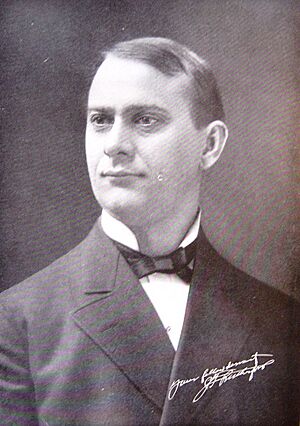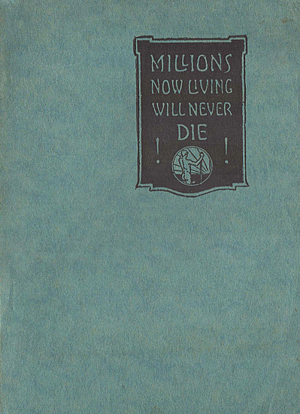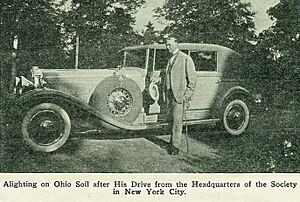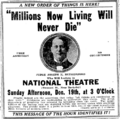Joseph Franklin Rutherford facts for kids
Quick facts for kids
Joseph Franklin Rutherford
|
|
|---|---|
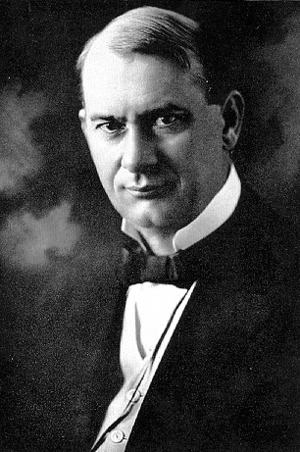
Joseph Franklin Rutherford
|
|
| Born | November 8, 1869 |
| Died | January 8, 1942 (aged 72) San Diego, California, US
|
| Occupation |
|
| Movement | Jehovah's Witnesses |
| Spouse(s) | Mary Malcolm Fetzer (m. 1891) |
| Children | 1 |
| Signature | |
 |
|
| Part of a series on Jehovah's Witnesses |
|---|
| Demographics |
| Jehovah's Witnesses by country |
| Organizational structure |
| Governing Body Faithful and Discreet Slave Watch Tower Bible and Tract Society Corporations of Jehovah's Witnesses |
| History |
| Bible Student movement Jehovah's Witnesses splinter groups |
| Beliefs & Practices |
| Doctrines |
| God's name · Eschatology · Blood · Disfellowshipping |
| Literature |
| The Watchtower · Awake! New World Translation |
| Controversies |
| Related people |
| Watch Tower Presidents |
| W.H. Conley · C.T. Russell · J.F. Rutherford · N.H. Knorr · F.W. Franz M.G. Henschel · D.A. Adams |
| Formative influences |
| William Miller · N.H. Barbour · George Storrs |
| Notable Former Jehovah's Witnesses |
| Raymond Franz · Olin Moyle |
Joseph Franklin Rutherford (November 8, 1869 – January 8, 1942) was an important American religious leader. He was the second president of the Watch Tower Bible and Tract Society, which is the main organization for Jehovah's Witnesses. Many of the beliefs and ways of doing things for Jehovah's Witnesses today were shaped by him.
Rutherford started his career as a lawyer and even served as a special judge. He became interested in the teachings of Charles Taze Russell, who founded the Bible Student movement. Rutherford joined this movement and was baptized in 1906. He became the legal advisor for the Watch Tower Society in 1907. In 1917, he was elected president. His time as president saw big changes and some challenges.
Contents
Leading the Watch Tower Society
Rutherford made many changes that helped shape Jehovah's Witnesses. He created a strong, central way of running the organization. He called this a "theocracy", meaning it was ruled by God through his organization. He encouraged all members to share their beliefs with others by going door-to-door. They also had to report their preaching activities regularly. He started training programs to help people speak well in public during their weekly meetings.
Rutherford also introduced new ideas about the Bible. He taught that Jesus' invisible return happened in 1914. He said that Jesus died on a tree, not a cross. He explained Armageddon as God's war against bad people. He also stressed that Christ's rule was very close. He told members not to celebrate holidays like Christmas and birthdays. He also said they should not salute national flags or sing national anthems. In 1931, he introduced the name "Jehovah's witnesses". In 1935, he started using the term "Kingdom Hall" for their meeting places.
He wrote 21 books for the Watch Tower Society. By 1942, the Society said almost 400 million of his books and booklets had been shared. Even though membership dropped in the 1920s, it grew more than six times by the end of his 25 years as president.
Early Life and Law Career
Joseph Rutherford was born on November 8, 1869, in Missouri. His family was Baptist and not wealthy. From age 16, he was very interested in law. He paid for his studies by selling encyclopedias and working as a court stenographer.
At 20, he became an official court reporter. He became a lawyer in 1892 when he was 22. He worked as a trial lawyer and a public prosecutor. He was also appointed as a Special Judge, which is why he was known as "Judge Rutherford."
Joining the Watch Tower Society
In 1894, Rutherford bought some Bible study books by Charles Taze Russell. Rutherford had not been very religious before this. But he was impressed by Russell's honest approach to religion. He wrote to the Watch Tower Society to thank them for the books. Twelve years later, he was baptized. He and his wife started holding Bible classes in their home.
In 1907, he became the legal advisor for the Watch Tower Society. He also started giving public talks as a representative for the Society. As Russell's health got worse, Rutherford traveled to Europe to represent him.
Becoming President
By 1916, Rutherford was one of the seven directors of the Watch Tower Society. When Russell died in October 1916, Rutherford helped lead the organization. On January 6, 1917, Rutherford was elected president of the Watch Tower Society. He was 47 years old. The new rules gave the president full control of the Society's work around the world.
However, some directors disagreed with Rutherford's leadership style. They felt he was too controlling. Rutherford believed they were trying to take over the Society. He removed four directors, saying they were not legally directors anymore. This caused a big split among the Bible Students. Many left the organization and formed new groups.
The Finished Mystery Book
In 1917, a book called The Finished Mystery was released. It was presented as the seventh volume of Russell's Bible study series. The book talked about Bible prophecies and was very popular. It was translated into six languages.
The book also strongly criticized religions and governments. It said that patriotism was wrong. Because of its strong views, the book was banned by the Canadian government in February 1918. Government officials in the United States also saw the book as dangerous.
Arrest and Release
In May 1918, arrest warrants were issued for Rutherford and seven other Watch Tower directors. They were accused of trying to cause disloyalty in the armed forces during World War I. On June 21, Rutherford and six others were sentenced to 20 years in prison.
Rutherford was worried that his opponents would take control of the Society while he was away. But on January 2, 1919, he learned he had been re-elected president. This made him feel that God wanted him in that position. On March 26, 1919, the directors were released on bail. In May 1920, all charges against them were dropped.
Changes and Growth
After his release from prison, Rutherford began to reorganize the Bible Student activities. In May 1919, he announced a new magazine called The Golden Age (later renamed Awake!). Bible Students were organized to share it door-to-door. He also started requiring weekly reports of their preaching work.
Rutherford held large international conventions. He urged all Bible Students to become "publicity agents" for God's Kingdom. He stressed that sharing the Society's publications from house to house was their main duty.
He wrote many books, including The Harp of God (1921) and Creation (1927). His publications reached millions of copies. In 1925, he gained full control over the teachings in Watch Tower Society publications. The Editorial Committee was dissolved in 1931. After that, Rutherford wrote every main article in The Watch Tower magazine until his death.
In 1924, Rutherford started radio broadcasts. These broadcasts reached many people, but his strong criticisms of religious leaders led to some networks banning his talks.
In 1928, Rutherford began to change how congregations were run. He stopped the system where elders were elected by voting. He said that electing elders was not based on the Bible. Instead, "service directors" were appointed in each congregation. These directors reported back to the Watch Tower Society.
New Name and Practices
At a meeting in 1931, Rutherford proposed a new name for the organization: Jehovah's witnesses. This helped to set them apart from other groups that followed Russell's teachings. Four years later, the term "Kingdom Hall" was introduced for their meeting places.
In the late 1930s, he encouraged the use of "sound cars" and portable phonographs. These were used to play Rutherford's talks to people on the streets and in their homes. In 1938, he used the term "theocracy" to describe the organization's government. This meant that God was ruling through the Watch Tower Society.
By the time of his death in 1942, the number of people attending the annual Memorial of Christ's death was 140,450.
Changes in Beliefs
Rutherford introduced many new teachings. He taught that Christ's rule began in 1914, not 1878 as Russell had taught. He also changed the date for the resurrection of Christians who had died.
He developed the idea of Armageddon as a worldwide war by God. He stressed the importance of God's name, "Jehovah." He taught that God's name would be cleared when millions of unbelievers were destroyed at Armageddon.
In 1927, Christmas was said to be from pagan origins. The next year, celebrating it was seen as supporting "Satan's organization." Other holidays and birthdays were also later discouraged.
Rutherford also changed the teaching that Jewish people would return to God's favor. He said that the Great Pyramid of Giza was not built under God's direction, but by Satan. This was different from Russell's teaching.
In 1935, Rutherford taught that the "great multitude" mentioned in the Bible would live forever on earth. This was a change from Russell's teaching that they would go to heaven.
He also objected to school students saluting the flag. He said that Jehovah's Witnesses who saluted the flag were breaking their promise to God. This led to many Witness children being expelled from school. The Watch Tower Society took many of these cases to court. These cases helped shape laws about freedom of speech and religion in the United States.
In 1936, Rutherford taught that Jesus was executed on an upright stake or "tree," not a cross.
His Personality
Rutherford was described as tall and strong, with a powerful voice. He was a very good speaker. While Russell was known for being kind, Rutherford was more direct and blunt. He was very firm about what he believed the Bible taught. He would not allow anything that seemed to go against the truth.
Some people found him to be very strong-willed. He was determined to fight for what he believed was right. After being released from prison, he felt that religious leaders and governments had worked together against him. He started using the term "Satan's organization" for this supposed conspiracy. He strongly criticized religious leaders, especially those of the Catholic Church.
Rutherford also had strong views on the role of women. He linked women's movements to satanic influence. He also encouraged followers to delay marriage and having children until after Armageddon.
Personal Life
Rutherford married Mary Malcolm Fetzer in 1891. They had one child, Malcolm, born in 1892. The couple later separated after Joseph Rutherford became president of the Watch Tower Society. Mary remained an active Jehovah's Witness until her death in 1962.
Rutherford had health problems, including a lung issue from his time in prison. Doctors advised him to live in a warmer climate. In 1929, a house called Beth Sarim (meaning House of Princes) was built in San Diego, California for his use. He lived there full-time later in his life.
Death and Burial
Rutherford died at Beth Sarim on January 8, 1942, at age 72, from colon cancer. His burial was delayed for five months because he wanted to be buried at Beth Sarim. He believed that resurrected Bible characters would live at Beth Sarim. However, Beth Sarim was not a legal cemetery.
Jehovah's Witnesses gathered many signatures to support his burial there. But officials in San Diego County refused to allow it. Rutherford was eventually buried in a private plot in Rossville, New York, on Staten Island.
After Rutherford's death, Nathan Homer Knorr became the new president of the Watch Tower Society.
Images for kids
See also
 In Spanish: Joseph Franklin Rutherford para niños
In Spanish: Joseph Franklin Rutherford para niños


